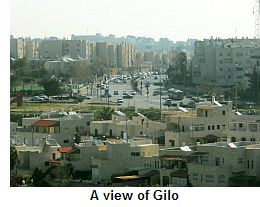 Israel has recently come in for international criticism over the approval for construction of 900 housing units in the southern Jerusalem neighborhood of Gilo. Irrespective of one’s views on this policy, it is the responsibility of the media to report on Gilo accurately and with the relevant context.
Israel has recently come in for international criticism over the approval for construction of 900 housing units in the southern Jerusalem neighborhood of Gilo. Irrespective of one’s views on this policy, it is the responsibility of the media to report on Gilo accurately and with the relevant context.
So how did some of the media refer to Gilo?
-
The “occupied Jerusalem suburb of Gilo.” – The Economist
-
The “Gilo settlement in Jerusalem.” – Reuters
-
A “Jewish settlement in East Jerusalem.” – BBC
-
A “controversial settlement on the outskirts of east Jerusalem.” – The Guardian
-
A “settlement in East Jerusalem.” – The Daily Telegraph
-
“one of a dozen Israeli settlements in mostly Arab east Jerusalem.” – AFP
-
A “part of Jerusalem claimed by Palestinians.” – LA Times
The Christian Science Monitor could not even decide on Gilo’s location, introducing it as a “Jewish settlement in East Jerusalem” in the first paragraph of the story and then referring to the “area in southern Jerusalem” in the next.
The prize for the worst inaccuracy, however, goes to The Times of London, whose staff editorial spoke of “Israel’s decision to go ahead with new settlements around Jerusalem.” Of course, Gilo is certainly not new and, while some existing areas are being developed within existing boundaries to allow for natural growth, there are no plans whatsoever on the part of the Israeli government to create any new settlements in the Jerusalem region.
Is this symptomatic of the journalistic laziness surrounding the entire issue of settlements and precisely what these actually refer to? After all, many media outlets do nothing to dispel the largely mistaken image of all Israeli settlements as a collection of isolated homes on windswept hilltops. In the case of Gilo, this is as far from the truth as could be possible.
And who then is influencing the language of those international politicians who are critical of the Israeli building plans? Are the media responsible for creating a skewed impression of Gilo due to past indiscretions regarding the language of settlements?
As Maurice Ostroff, writing in the Jerusalem Post, explains:
The $64,000 question then, is whether Gilo is in fact a settlement and if so, what type of settlement it is. To all who prefer to analyze a situation before arriving at a conclusion it is important to look at the facts in context. …
The reality is that Gilo is very different than the outposts in the West Bank. It is not in east Jerusalem as widely reported. It is a Jerusalem neighborhood with a population of around 40,000. The ground was bought by Jews before WWII and settled in 1971 in south west Jerusalem opposite Mount Gilo within the municipal borders. There is no inference whatsoever that it rests on Arab land.
The current building approval was not a deliberately provocative political decision by Binyamin Netanyahu as reported in some media. The plan was initiated a long time ago by the Israel Land Administration. Since Gilo is an integral part of the city, the approval was given by Jerusalem’s Construction and Planning Committee and, as Jerusalem mayor Nir Barkat said in a statement released by his office, “Israeli law does not discriminate between Arabs and Jews, or between east and west of the city. The demand to cease construction just for Jews is illegal, as in the US and any other enlightened place in the world. The Jerusalem Municipality will continue to enable construction in every part of the city for Jews and Arabs alike.”

The Washington Post, at least, was more nuanced in its language, describing Gilo as a “disputed neighborhood of Jerusalem” and providing a map to put Gilo in some geographical context.
CNN also referred to Gilo as a “disputed neighborhood on Jerusalem’s southern outskirts”. Indeed, CNN is one of a number of media outlets including The New York Times, Washington Post, Associated Press, Boston Globe and CBS News, which have all, in the past, recognized the particular geography of Gilo, referring to it as a “neighborhood.”

